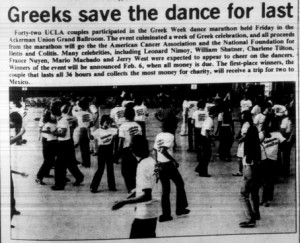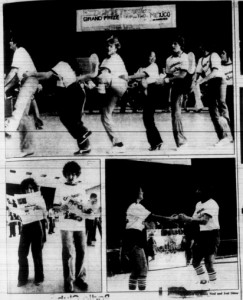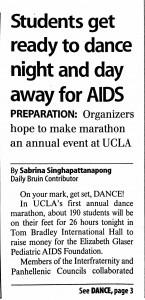Bruins were dance marathon-ing for diseases years before UCLA professor Michael Gottlieb identified acquired immune deficiency syndrome and the AIDS epidemic was discovered.
The Dance Marathon we know today debuted in April 2002 to raise money for the Elizabeth Glaser Pediatric AIDS Foundation, but in 1979, the event began when Greek life revived UCLA’s annual Greek Week and raised money for the American Cancer Society and the then-National Foundation for Ileitis and Colitis.

The event has always been a charity event, but sometime after the Interfraternity and Panhellenic Councils organized the event in 1979, it lost steam like many other UCLA traditions such as Mardi Gras and Spring Sing, the latter of which has experienced many comebacks. It returned in 2002, under the councils’ guidance, as well as the Undergraduate Students Association Council, the Student Alumni Association and the On-Campus Housing Council. Since then, the Pediatric AIDS Coalition formed and took over.
Steve Sann, a Lambda Chi Alpha alumnus as well as current chairman of the Westwood Community Council, was one of the co-founders of the 1979 event.
“It was kind of the height of the disco era,” Sann said. “There were no ‘moralers’ or ‘massagers.’ We were not that fancy.” While students cheered dancers on, there were no official volunteers charged with boosting participants’ spirits through the highs and lows of their all-nighter.

The popularity of dance marathons can trace its history much further back, though, to the Great Depression, when people competed to see who could stay awake and dance the longest to win money or fame. The phenomenon was heavily dramatized in the play and 1969 film “They Shoot Horses, Don’t They?,” an existential contemplation of human competitiveness and desperation that ends with the two protagonists, who have fought tooth and nail to stay in the dance marathon, at the pinnacle of despair.
Since then, college students have reinvented dance marathons as charity events, the most well-known being Pennsylvania State University’s THON, a 46-hour event that raised $13 million last year to help those impacted by childhood cancers.
Neither the 1979 nor today’s UCLA Dance Marathon attempts such grueling or ambitious goals. In 1979, dancers stayed on their feet for 36 hours and since 2002, they have managed to dance away 26.
Over the past five years, the Pediatric AIDS Coalition has annually raised more than $400,000. Last year, it raised about $446,000 – a $400,000 increase since the event’s second year in 2003.

Daily Bruin coverage certainly reflects the change. In 2002, The Bruin’s event coverage featured no art, but a year later, a photo of the event ran on the paper’s front page.
Since 2011, the paper has published some form of live coverage, organizing a slew of writers, photographers and videographers to document one of UCLA’s stranger rituals.
